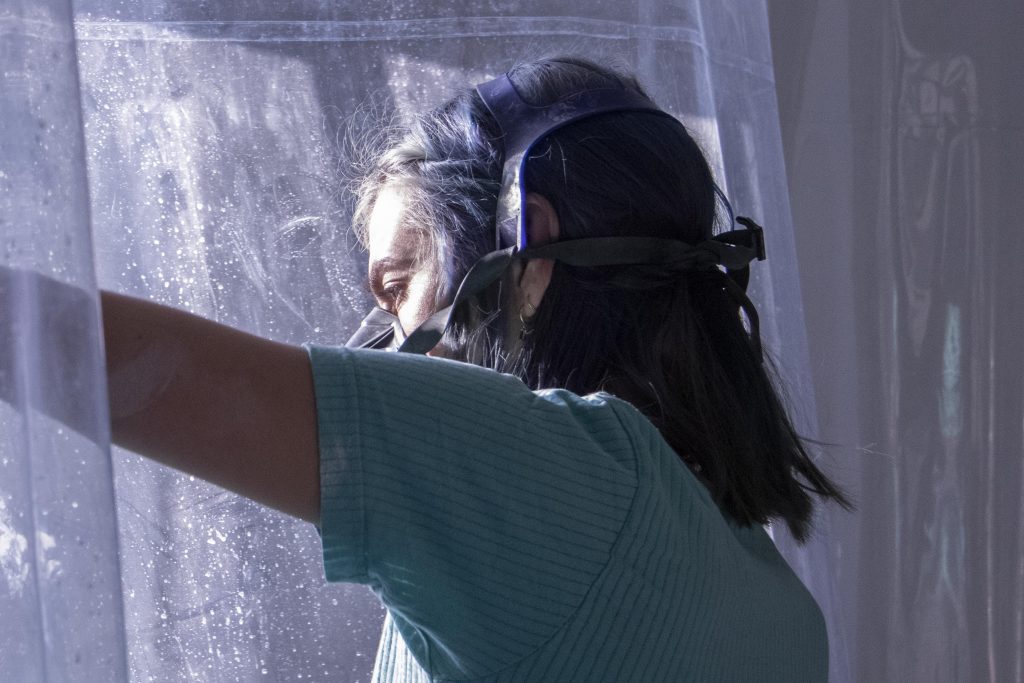理查德·班皮奖现由大家耳熟能详的梅森瓷厂、梅森瓷器基金会、德国陶瓷之友协会共同支持举办。此奖以20世纪初的艺术先锋派陶艺家理查德·班皮(Richard Bampi,1896–1965)命名。而本次访谈的对象,即是理查德·班皮奖的新锐得主——海伦娜·塞科特(Helena Sekot)。
海伦娜·塞科特的作品把握了我们在“搜藏访谈丨岁末特辑:关于艺术、当下与未来”中谈及的一个很重要的点,就是她不局限于单一一种塑造材料,将瓷与玻璃同时作为载体,而最后呈现了海伦娜·塞科特本人认为符合当代艺术潮流的作品。而这类艺术设计恰恰是我们殷切希望在现代欧洲陶艺中触及和遇见的。
在今日(2024.3.15),海伦娜·塞科特与其他得奖选手的参赛作品会陈展于梅森瓷器博物馆,与公众相遇。
受访人:海伦娜·塞科特(理查德·班皮奖获得者)
Interviewer: Dingwei Yin
企划&责任编辑:搜藏控;宋魏(搜藏控艺术总监,海兰德中国 Herend China)
(郑重声明:本文所用全部图片,版权均归属海伦娜·塞科特女士所有;本文未经搜藏控及采访双方许可,不得擅自转载。)
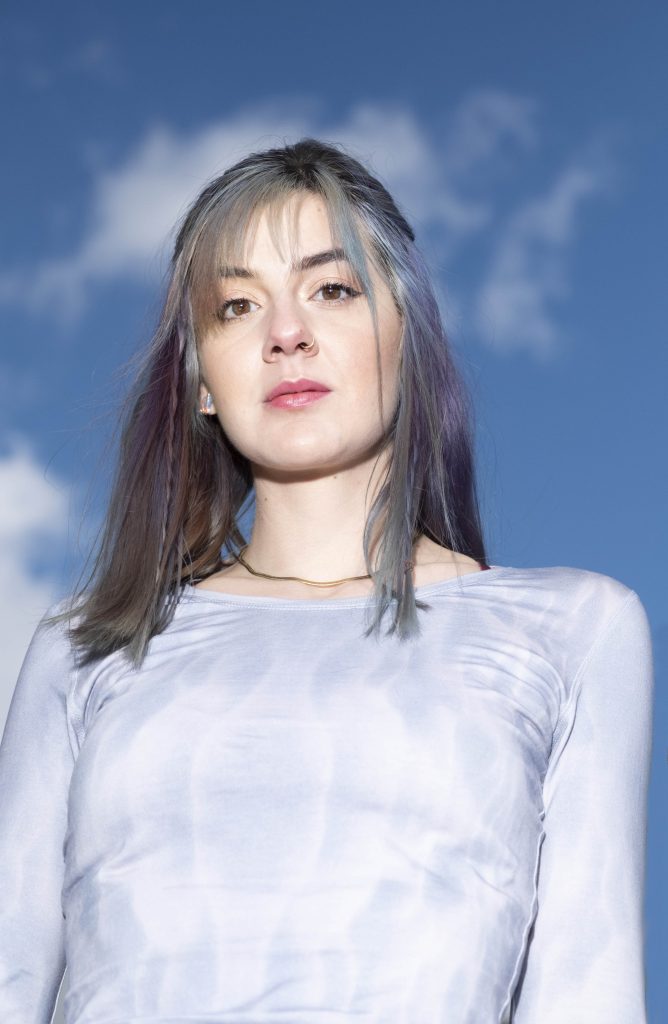
PART. 01
Yin: Why did you select ceramics and glass as your major? Is there a special reason?
您为什么会将陶瓷和玻璃艺术选择为您的专业?是否有特殊的缘由?
Hou: Before my Bachelor studies, I didn’t know much about ceramics and glass. During my teenage years, I spent a lot of time drawing and painting. Looking back, I can see that I had already developed an interest in working sculpturally because I applied a lot of texture and three-dimensional materials onto canvases. I also had a special interest in body painting and worked as a makeup artist from the age of fifteen. I used various materials to sculpt prosthetics and spent hours applying makeup to myself to become an alien or any other fantasy creature.
在攻读学士学位之前,我对陶瓷和玻璃了解不多。在我青少年时期,我花了很多时间绘画。回想起来,我发现我已经对雕塑创作产生了兴趣——因为我在画布上应用了大量的肌理和三维材料。我还对身体彩绘特别感兴趣,并从十五岁开始担任化妆师。我使用各种材料来雕刻假肢,并会花几个小时给自己化妆,让自己变成外星人或任何其他幻想生物。
After graduating from high school, I traveled and lived abroad for a year. When I returned to my hometown, Koblenz, I finally found out about the Institute for Ceramics and Glass Art (IKKG) in a town right next to Koblenz called Höhr-Grenzhausen. This town has a vast ceramic history that I had only paid slight attention to until this point. I applied and started my Bachelor studies in the glass department but simultaneously began working with ceramics. It was as if a new world of artistic expression had opened up for me.
高中毕业后,我出国旅行并生活了一年。当我回到家乡科布伦茨时,我终于在科布伦茨旁边的一个名为赫尔-格伦茨豪森的小镇上找到了陶瓷和玻璃艺术研究所(IKKG)。这个小镇有着悠久的陶瓷历史,直到此时我才注意到这一点。我申请并开始了玻璃系的本科学习,同时也开始制作陶瓷,这仿佛一个艺术表达的新世界为我打开了。
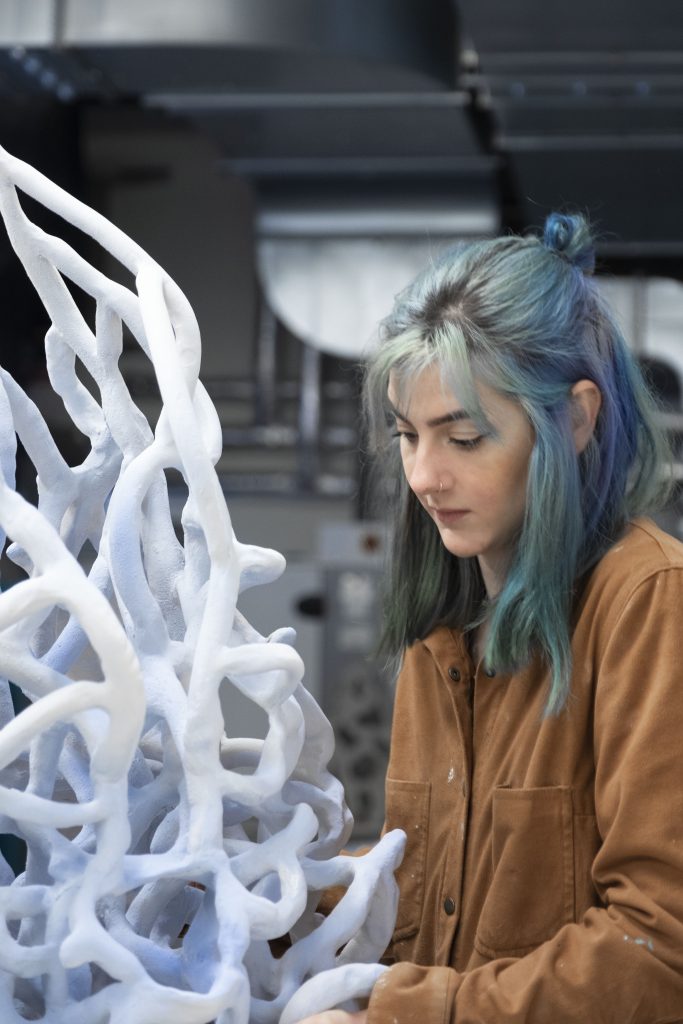
From the beginning, I loved the experience of sculpting with clay because it felt like having a dialogue. I realized that the clay was memorizing the movement and pressure I was applying with my hands. Being challenged to manipulate the effect of gravity, it felt like I quickly figured out my personal form exploration with the material. Working with clay brought out a form language of my own that I had not known before. Later, I realized that my approach to working with bodily structures in a symmetrical layout still originates from my experiences as a makeup artist. I think clay is a great material for transferring previously gained working experiences because you can shape it so intuitively.
从一开始,我就喜欢用粘土去塑型的体验,因为感觉像是在与雕塑进行对话。我意识到粘土在记忆我的手所施加的动作与压力。面对利用重力效应的挑战时,我很快就找到了藉由这种材料而进行个人风格探索的方式。与粘土打交道激发出了一种我从前并不知道的、属于自己的形式语言。后来我意识到,我在对称布局中处理雕塑结构的方法仍然源于我作为化妆师的经历。粘土是一种很好的材料,能够传递以往所获得的创作经验,因为你可以凭直觉去塑造它。
After spending some time exploring ceramics, I did a series where I used glass instead of glaze by fusing dichroic glass sheets onto my ceramic pieces. I value the element of unpredictability inherent in working with mineral materials like glass and ceramics. Especially when I fuse glass onto my pieces, I give away control. I create the setup, but in the end, it is always a great surprise to open the kiln and see what forms have shaped under the heat. Until now, I feel like clay is a crucial medium for me to find and give shape. I like to combine it with other materials to stretch and shape its diverse expressive qualities.
花了一些时间探索陶瓷之后,我做了一个系列作品,用玻璃代替釉料,将二向色玻璃片熔合到我的陶瓷作品上。我觉得诸如玻璃和陶瓷等矿物材料在创作过程中所具有的不可预测性非常重要,尤其是我将玻璃熔合到作品上时,(因为材料的不可预测性)我放弃了(对作品的)控制权。尽管是我创作了这种设计,但最终打开窑炉查看烧制后的产物的时候,总是会有巨大的惊喜。到目前为止,我觉得粘土是我寻找和塑造形状的关键媒介,我喜欢将它与其他材料结合起来,从而拉伸和塑造它的各种表现力。

PART. 02
Yin: Most people have known you since you won the first prize of Richard Bampi Preis. Can you tell us what this Award is? And which artwork you made in this event?
绝大部分的人通过理查德·班皮奖认识您,可以介绍一下这个奖项么?您在这个活动中做了什么作品?
Hou: The Richard Bampi Prize is held by the “Gesellschaft der Keramikfreunde e.V.” foundation and supports emerging ceramic artists with the heritage of Avant-garde ceramicist Richard Bampi since 1969. Artists who are working with the medium ceramics can apply with a total of five works from their portfolio. A jury then chooses a selection of works for in-person evaluation. The award ceremony marks the opening of the exhibition, which is held in a different location each time. Fortunately,the 2022 award was hosted by the Porcelain Manufactury Meissen. In addition to the cash prize, David Fernando Torres,Philsoo Heo, and myself received the opportunity of having an artist residency at the manufactury to realize our own projects.
理查德·班皮奖由陶瓷之友协会举办。自 1969 年以来,该基金会一直秉承前卫陶艺家理查德·班皮 (Richard Bampi) 的传统,为新锐陶瓷艺术家提供支持。使用陶瓷作为媒介的艺术家可以从其作品集中选出共计五件作品来申请。然后评审团选出一批作品进行现场评估。颁奖仪式就是这个评比展览的开幕式,展览每次在不同的地点举行。幸运的是,2022 年奖项由梅森陶瓷制造厂主办。除了现金奖励外,David Fernando Torres、Philsoo Heo 和我还获得了在工厂驻留以完成我们自己的项目的机会。
It was a special experience to immerse myself into the tradition of European Porcelain making and being able to challenge it with my own artistic approach. I saw the opportunity to use already existing tableware molds to cast shapes that I would then deform and arrange on magnetic glass boards. My artistic interest here was in seeing the vessels as bodily shapes and breaking them apart to show the delicate, bone-like quality of the porcelain. I spent a total of five weeks in all the different departments from casting and pouring to underglaze, decor glaze and painting, grinding and mounting. The results of the residency will be showcased in an exhibition at the Museum of Meissen from March 2024.
这是一次特别的经历,我沉浸于欧洲瓷器制作的传统中并以自己的创作方法去挑战它。我看到了使用现有餐具模具来铸造形状的机会,然后将其变形并排列在磁性玻璃板上。在这里,我的艺术兴趣在于将器皿视为躯体并将其分解,以展示出精巧的、骨骼般的瓷器品质。我花了总共五周的时间在不同的部门里,从铸造和浇注到釉下彩、装饰釉和绘画、还有研磨和组装。驻留项目的成果会从 2024 年 3 月起在梅森博物馆展出。
Q: This year you had your solo exhibition named Lichte Substanz. Can you give us a brief introduction to it?
2023年您做了一个个展《发光物质》,能给我们做一个简短的介绍么?
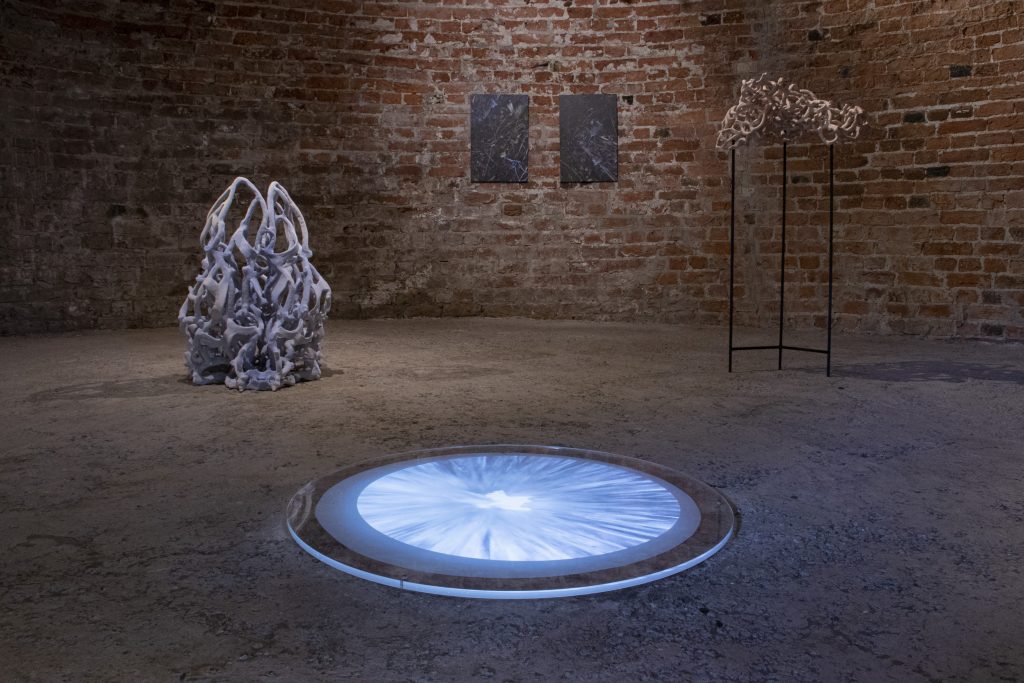
Hou: I was very happy to receive the Oldenburg Ceramic Prize “Keramik im Pulverturm” and therefore had the opportunity to exhibit in the historic powder magazine from 1529. It was challenging and inspiring to work with the specific qualities of this brick-built tower. I decided to create a multimedia installation that included a video projection with sound, photographs, printed textiles, and numerous ceramic and glass sculptures. The title “Lichte Substanz” (light/luminous substance) refers to one of my main artistic interests. It is about expressing the duality between having a mortal, tangible body and, in contrast to that, a seemingly non-physical, intangible consciousness.
我很高兴获得奥尔登堡陶瓷奖——“在火药塔之中的陶瓷”,并因此有机会在这座建立于1529年的古老火药塔里展出作品。这座砖砌塔有着独特的特性,在这里创作既有挑战性又让我振奋。我决定创作一个跨媒介装置作品,包括带有声音的视频投影、照片、印制织物以及大量陶瓷和玻璃雕塑。标题“Lichte Substanz”(发光物质)指的是我的主要艺术偏好主题之一。它是表达在注定消亡的、有形的身体和与之相反的、看似非物质的、无形的意识之间的二元性问题。
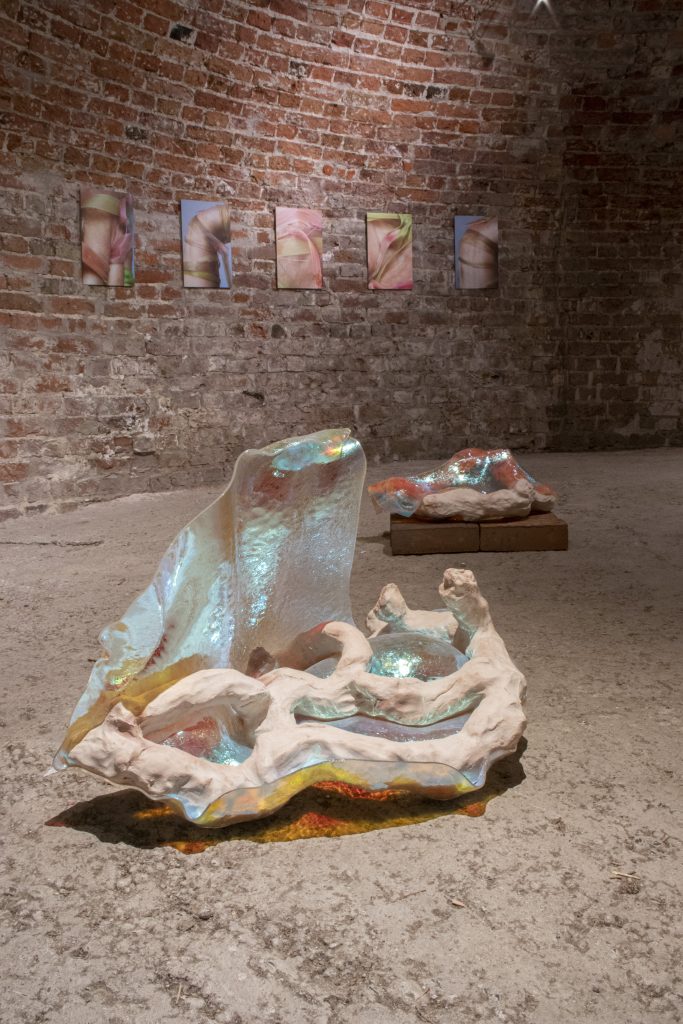
In my works, I often like to let the materials speak about this polarity and challenge them to change their appearance. For me, clay represents the body, the earth, the physical.
在我的作品中,我喜欢用材料来表达这种两极性问题,并挑战改变它们的外观。对我来说,粘土代表着身体、地球、物质。
In my sculptural series “Between Earth and Sky,” the glass adds a translucent skin to the ceramic pieces. It reflects the light and gives off an auratic sheen, which colors the clay and the surrounding space in an ephemeral way. The video and sound installation “Stream” shows a projection of streaming water. The continuity of the flowing water evokes a hypnotizing motion, almost like opening a portal to another state of consciousness. The subtle but continuous sound of the streaming water emphasizes the effect, simulating the viewer’s perception on an auditory level.
在我的雕塑系列《大地与天空之间》中,玻璃为陶瓷件添加了一层半透明的表层,反射光线并呈现出变幻莫测的光泽,短暂地为粘土和周围空间施以颜色。视听装置《溪流》展示了流水的投影。流水的连续性唤起了一种催眠般的状态,几乎就像打开了通往另一种意识状态的门户。微妙但连续的流水声强调了这种效果,在听觉层面上模拟了观看者的感知。
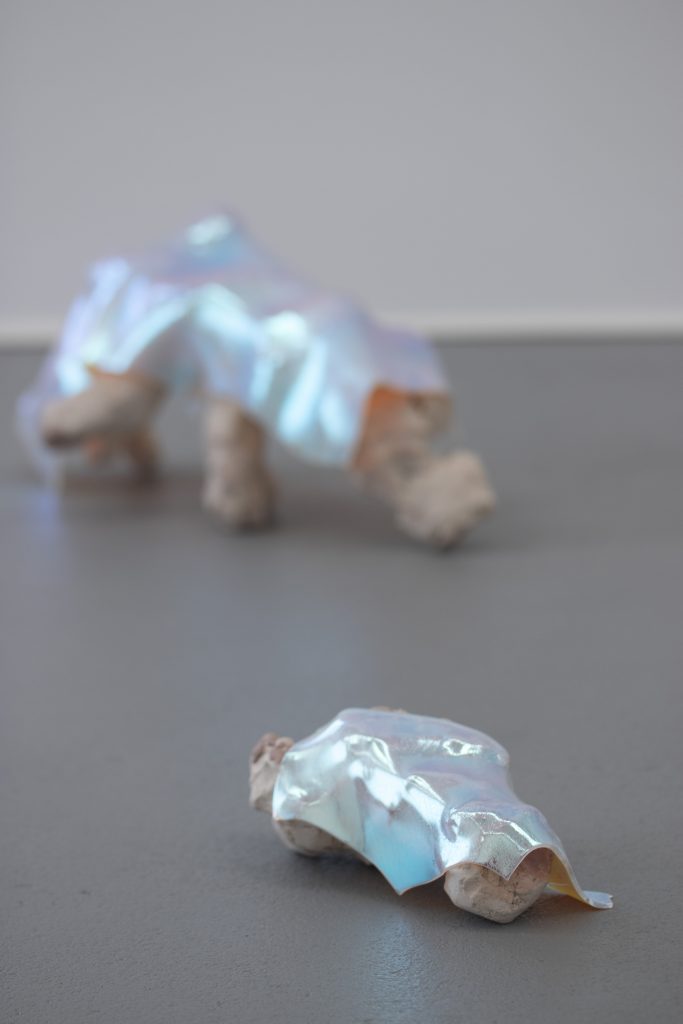
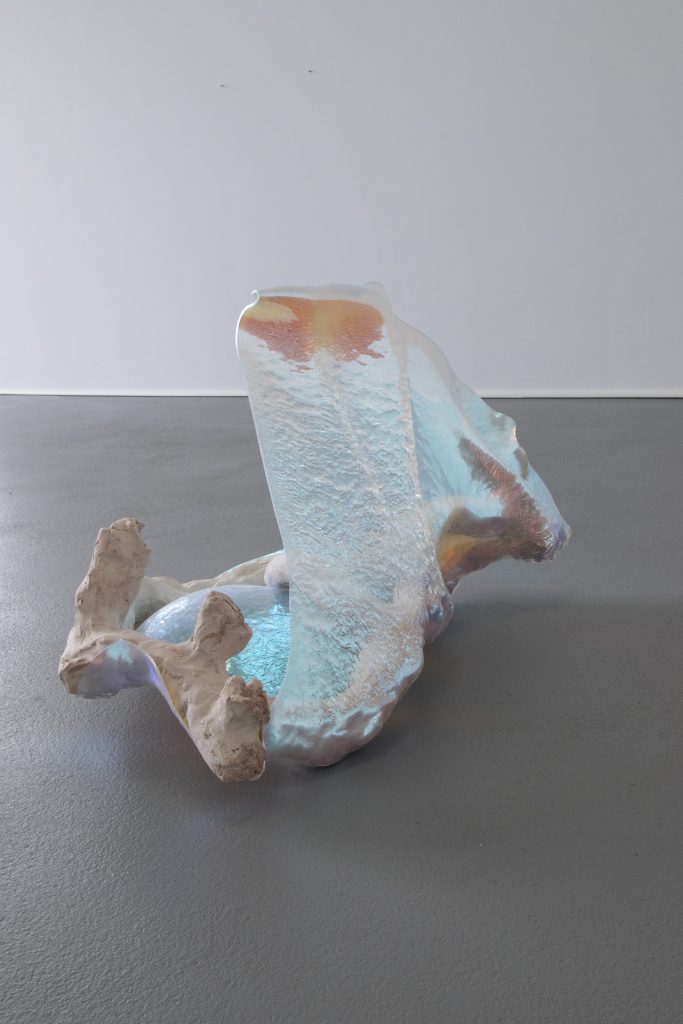
The textile work “Existence Becomes Rhythmical, Spacious, and Eventually Void” is a four-meter-long printed banner that served to activate the height of the tower. The motive of the print is a photograph I took of a snow landscape and then digitally mirrored and copied to create a column of snow patterns. I liked integrating snow as a material because it represents impermanence and transformation to me.
纺织作品《“存在”变得有韵律、广阔,而最终虚无》是一条四米长的印刷横幅,充分利用了砖砌塔的高度。该印刷品的主题是我拍摄的雪景照片,经过数字镜像和复制创建了一列雪的图案。我喜欢将雪作为一种材料,对我来说它代表着短暂无常和转变。
Aligned with the works “Stream” and “Existence Becomes Rhythmical, Spacious, and Eventually Void,” I placed the sculptural ceramic work “Chapel.” Strands of clay are connected to create a skeleton, a kind of architectural network that represents the idea of rhythmic growth. The texture of the engobe is porous and rough, like it was covered in snow or sand, making the sculpture breathe and connect to the other works in the room. It was quite beautiful to realize that the exhibition space itself was built from the same material as my ceramic sculptures. The building, with its brittle red bricks, expresses a similar kind of durable fragility that I often find in my works.
与前两件作品同系列的还有雕塑陶瓷作品《教堂》:粘土串连起来形成骨架,有点像是建筑网络,传达出一种有节奏的生长的想法。釉底的质地多孔且粗糙,就像被雪或沙子覆盖一样,使雕塑能够呼吸并与房间里的其他作品连接起来。意识到展览空间本身就是用与我的陶瓷雕塑相同的材料建造的,真是太美妙了。这座建筑采用易碎的红砖,表达着一种与我作品中经常出现的概念相似的持久脆弱性。
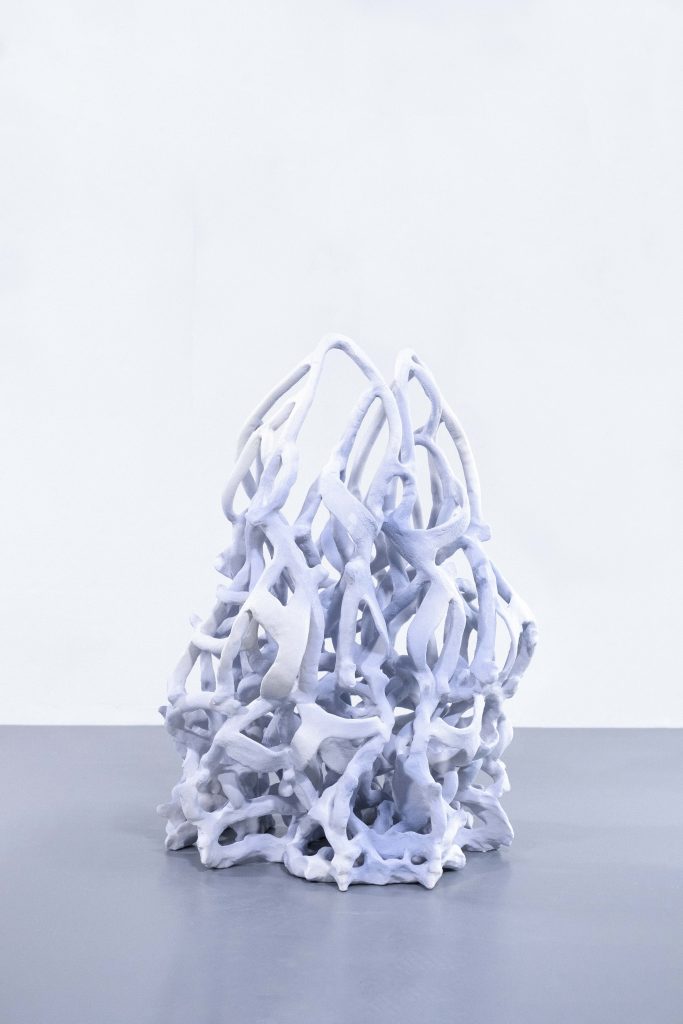
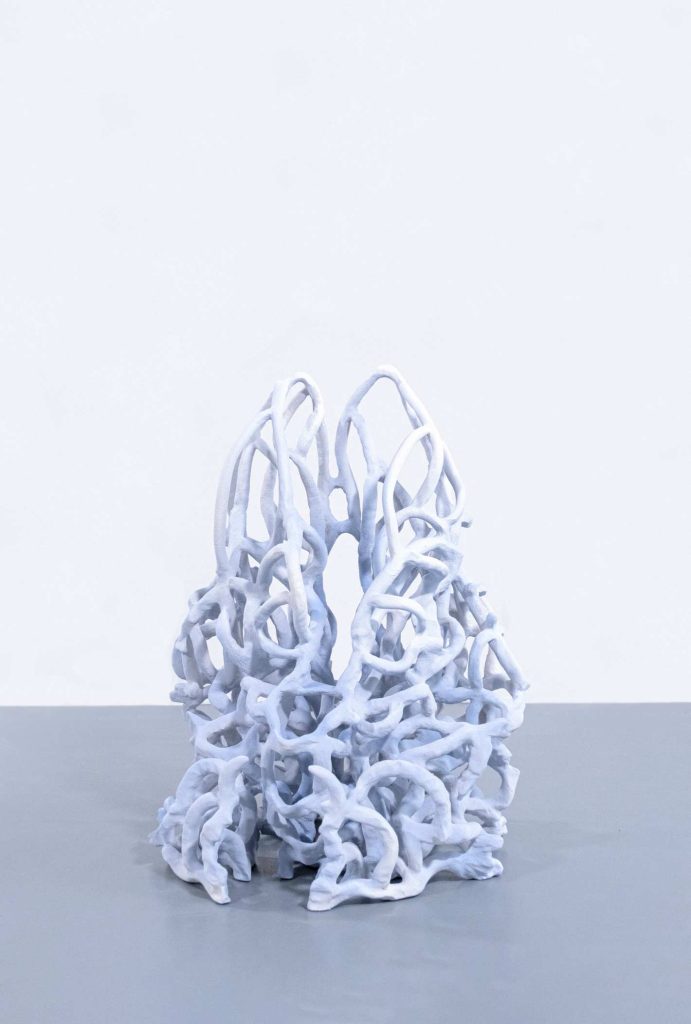
PART. 03
Yin: You present a lot of feelings about nature. The theme of nature plays a key role in German culture and is reflected in many artists’ works. As a female artist, why is this topic important to you?
在你的作品中,您表达了很多关于自然的感官感受。自然的主题在德国文化中扮演了重要的角色,并且反映在众多的艺术作品中。作为一个女性艺术家,这个主题为什么对您如此重要?
Hou: I think the term “nature” is very broad and links to a lot of topics. But dealing with the definition of nature and therefore dealing with the definition of our own nature feels like a contemporary necessity. For me, observing the intricate designs of any living organism, trying to witness the intelligence that has shaped through endless evolutionary processes is very inspiring. Our lives as human beings on this earth are so short. It seems as if our minds cannot even get close to understanding what evolutionary intelligence our bodies and our planet body carry. We can neither imagine the vastness of space in our expanding universe, nor the geological history a little grain of sand went through. I think the complexity of nature, the unknown mysteries, and the vastness itself have been scary to humans. In the process of industrialization and modernization, with great ignorance we have come to build the illusion that we are in control of it. But in the end, we as biological creatures cannot escape the pace of nature. As it is who we are and what nourishes our very own survival.
我认为“自然”一词非常广泛,涉及很多主题。但阐述自然的定义进而阐述我们自己的天性,感觉像是当代的必然。对我来说,观察一切生物体的复杂设计、试图见证通过无尽的进化过程形成的智慧是非常有启发的。我们人类在这个地球上的生命如此短暂,我们的思想可能甚至无法理解我们的身体和地球本体所承载的进化智慧。我们无法想象不断膨胀的宇宙有多么广阔,也无法想象一粒沙子所经历的地质历史。我认为大自然的复杂性、未知的奥秘以及浩瀚本身都让人类感到恐惧。在工业化和现代化的过程中,在极大的无知中,我们产生了我们可以控制自然的错觉。但最终,我们作为生物体,还是无法逃脱自然的节奏。因为这就是我们的本质,也是我们赖以生存的因素。
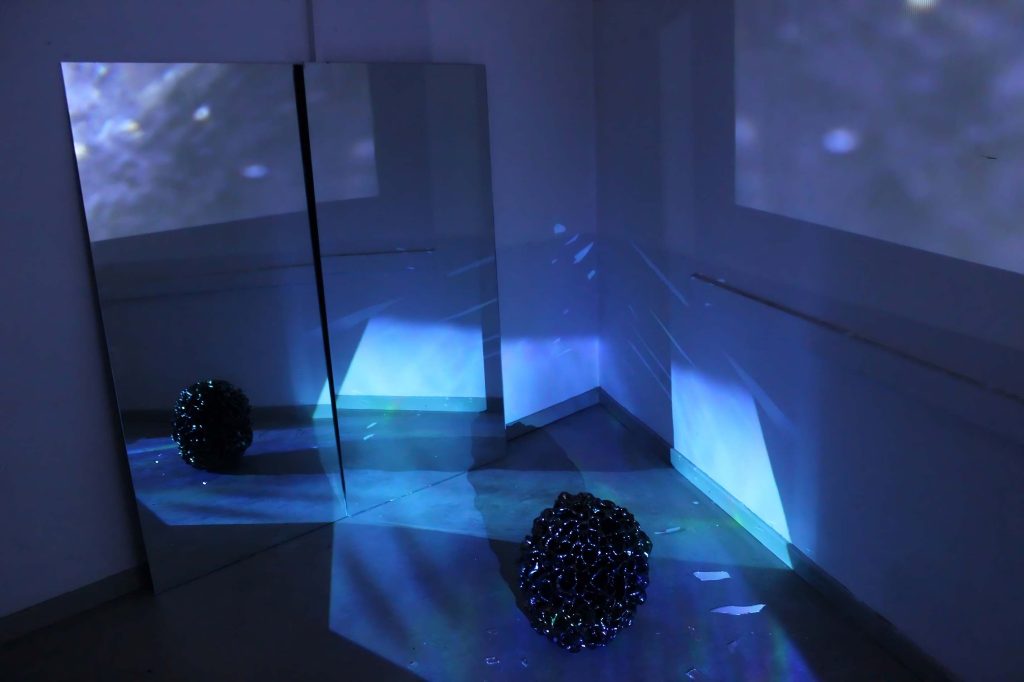
One day, we give our bodies back to the circuit. As mortality and the decay and transformation of organic matter are a crucial part of the process of life. Seeing chaos, the falling apart of order as a natural phenomenon which is deeply integrated in the coding of nature, is a challenging concept to accept. Dealing with death is not really integrated in the western, modern world. It is mostly seen as an obstacle that humanity needs to overcome, prolong, or simply ignore. But I think this transformational process in essence is a creative force. Ultimately, we are continuously asked to die small deaths of transformation. My artistic practice gives me space to utilize and express those paradox observations in a creative way.
有一天,我们会将身体重新投入自然界的循环往复之中。因为死亡以及有机物的腐烂和转化是生命过程的关键部分。将混乱(秩序的崩溃)视为一种包含在自然法则内的自然现象,是一个难以接受的概念。应对死亡的观念并没有真正进入西方现代世界,而是通常被视为一种人类需要去克服、延长或干脆忽视的障碍。但我认为这个转变的过程本质上是一种创造力。最终,我们不断地被要求去弱化死亡 (这一自然)的转换形式。我的艺术实践给了我空间,以创造性的方式去利用和表达这些悖论观察。
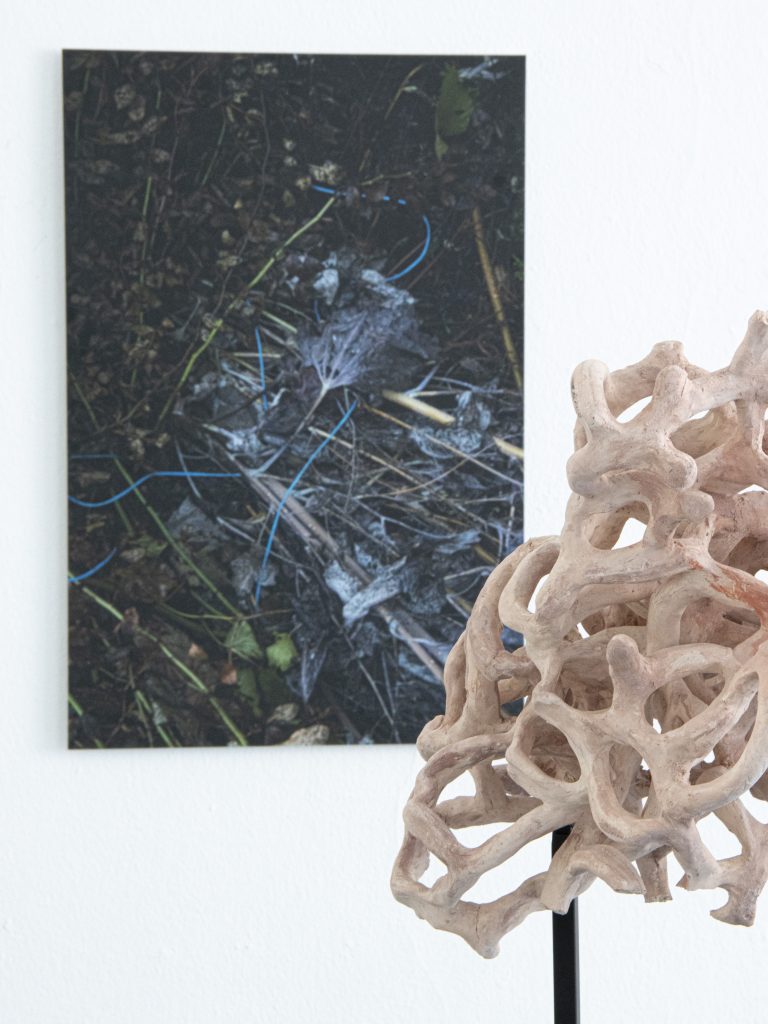
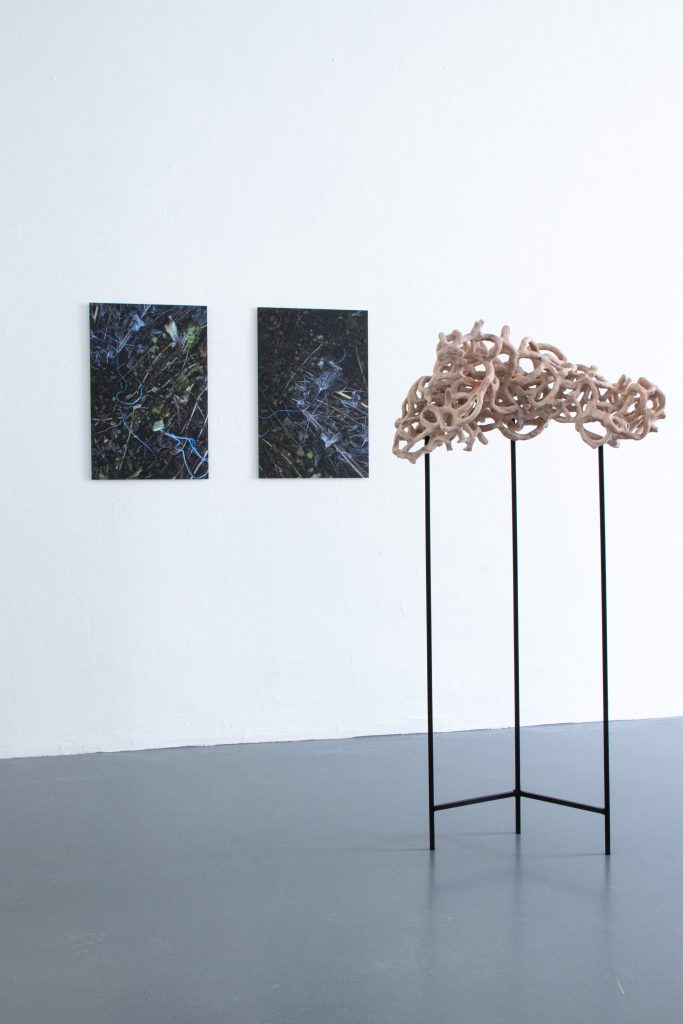
Q: Due to the restriction of materials, Ceramics and porcelain are hard for most people to present in contemporary art. Through your works, you break these restrictions and use ceramics freely in a contemporary tone. How do these ideas come to your mind?
由于材料本身的限制,陶瓷是很难在当代艺术中去进行运用的材料。通过您的作品,您打破了这个局限,并游刃有余地使用这种材料。这个观念如何在您的思考中形成的?
Hou: From what I previously expressed about my artistic journey, I guess it becomes quite clear that my approach to any material is very open. I never learned to use ceramics in a technical way; I use it in a way that interests me artistically. Aside from the great value of handcraft, it can be quite helpful to be unbiased when approaching a material. In my bachelor studies, I had my atelier in the glass workshop and therefore used tools and machines that are not typically used for ceramics. In my artistic education, I was always encouraged to explore those non-technical approaches and will curiously continue to do so. I do not believe that there should or could ever be a restriction of materials in contemporary art. In the end, materials are just materials. It always depends on the nuances you decide to emphasize in a material and what context you frame it in.
从之前我讲述过的艺术历程来看,显然我对任何材料的态度都是非常开放的。我从来没有以技术性的方式去学习运用陶瓷,而是以一种让我在艺术层面上感兴趣的方式。除了手工艺的巨大价值之外,这种观念也有助于我以不带偏见的中立态度去接触某种材料。在本科学习时期,我的工作室在玻璃车间,因此使用的工具和机器都不是专门用于陶瓷生产的。我所受到的艺术教育一直鼓励我去探索那些非技术性的方法,并始终对此抱有好奇心。我不认为当代艺术中应该或可能存在对材料的限制。说到底,材料只是材料,它始终取决于艺术家决定如何强调这些材料中的细微差别,以及在何种背景下去构建它。
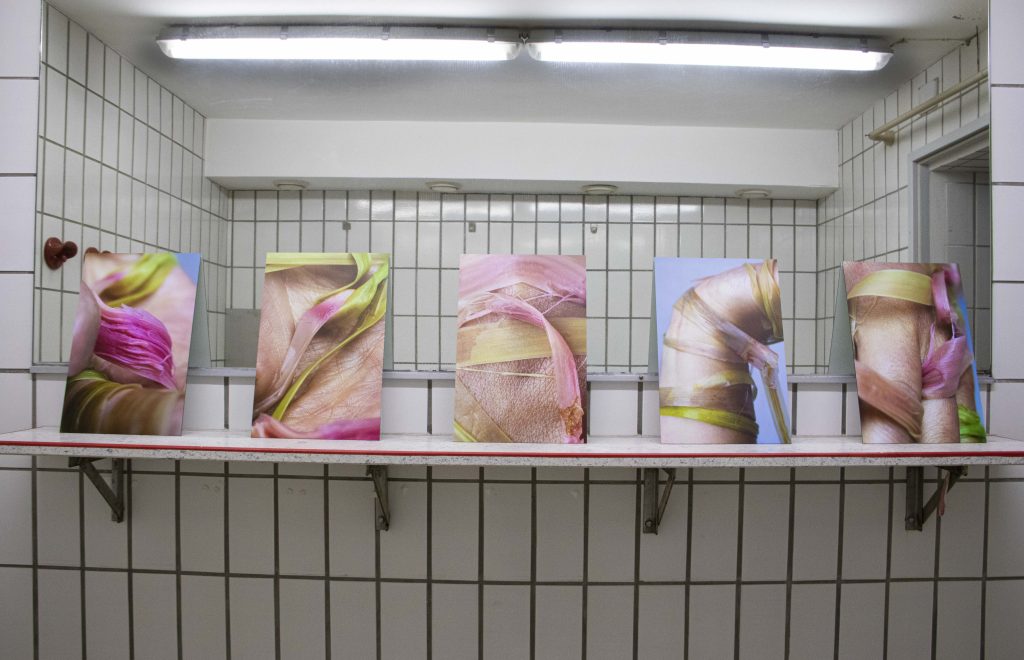
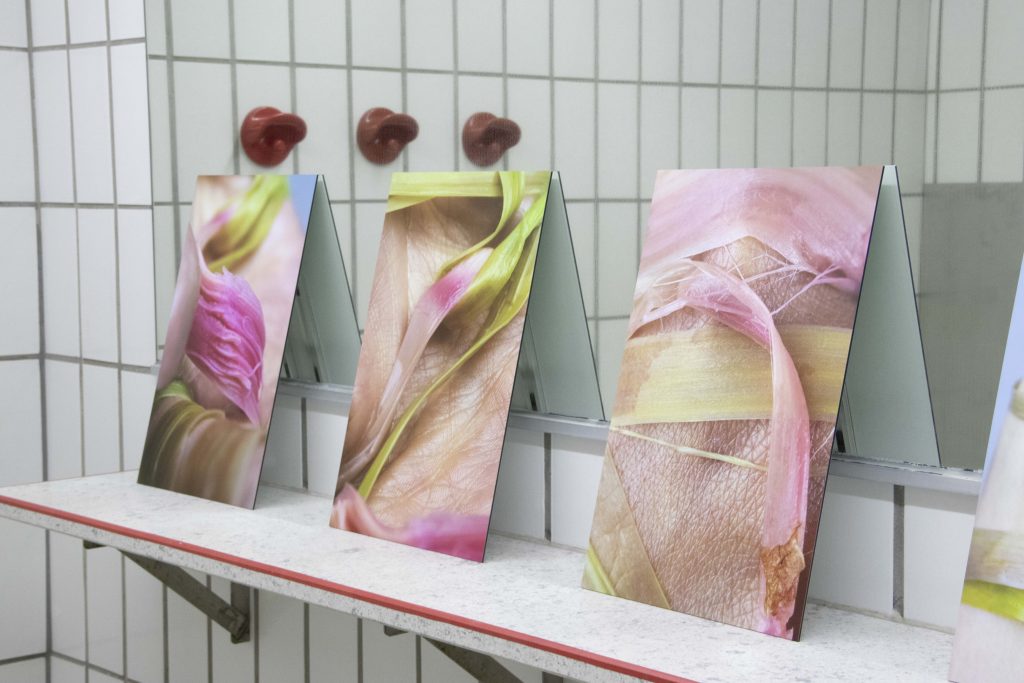
Q: You are tempted to use various materials, such as light, and photography. How do you deal with different materials in your works, especially when you present in a museum and gallery space?
您尝试使用了多种混合的材料,例如光线和摄影等等。您怎样在您的作品中处理它们?尤其是在一个博物馆的展览空间里?
Hou: My interdisciplinary approach to materials comes quite naturally to me. After using photography and videography to document my makeup looks when I was a teenager, I later discovered photography as a medium to pursue my interest in colors and shapes in my surrounding nature. The camera lens helps me perceive with more attention to detail and enter a world within the subject. For instance, I can get lost in the branching of a tree and for a moment forget that it is a tree that I am looking at. My artistic photographs frequently serve as a bridge, connecting my sculptural works with the immediate surroundings. I like to create this dialogue of different mediums and see how they can portray a similar idea in a very different language. When exhibiting in a museum or gallery, I attempt to extend this dialogue with the space and create an atmosphere in which the viewers can immerse themselves.
我对材料的跨领域式处理是很自然的。从我少年时期用摄影摄像来记录我的妆容之后,我便找到了摄影这种方式,以其为媒介来践行我对周围自然的色彩与形状的兴趣。相机镜头帮助我更加关注细节并进入拍摄对象的世界。例如,我可能会迷失在一棵树的树枝中,在某一个片刻我会暂时忘记我正在看的是一棵树。我的艺术照片经常充当桥梁,将我的雕塑作品与周围的环境连接起来。我喜欢创造不同媒介的对话,看看它们如何用一种非常不同的语言来描绘类似的想法。当在博物馆或画廊展出时,我试图扩展与空间的对话,创造一种让观众沉浸其中的氛围。
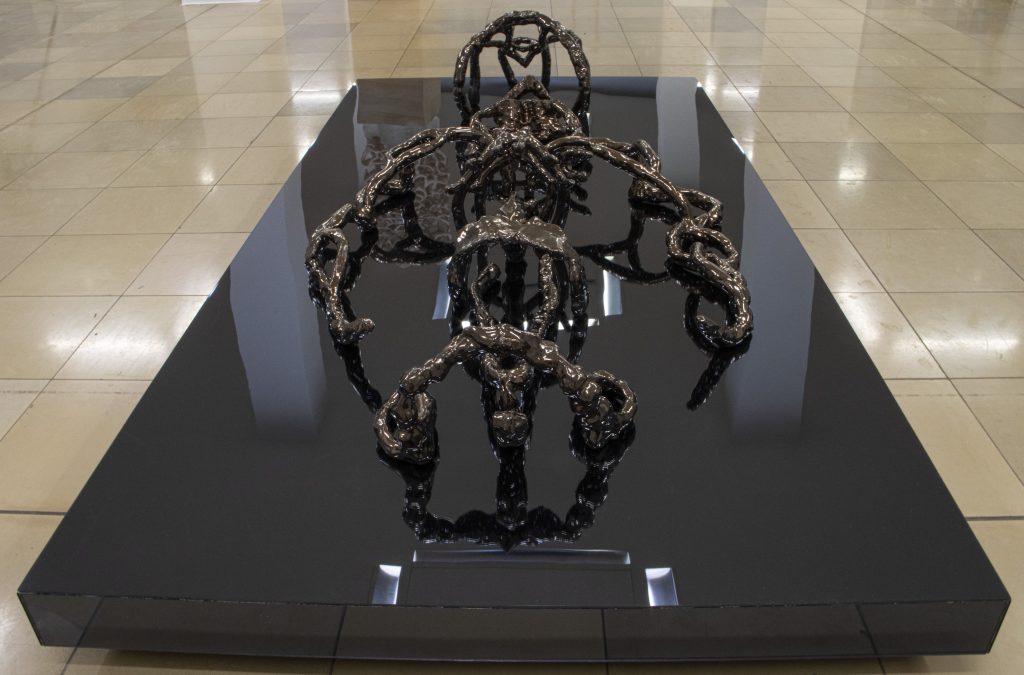
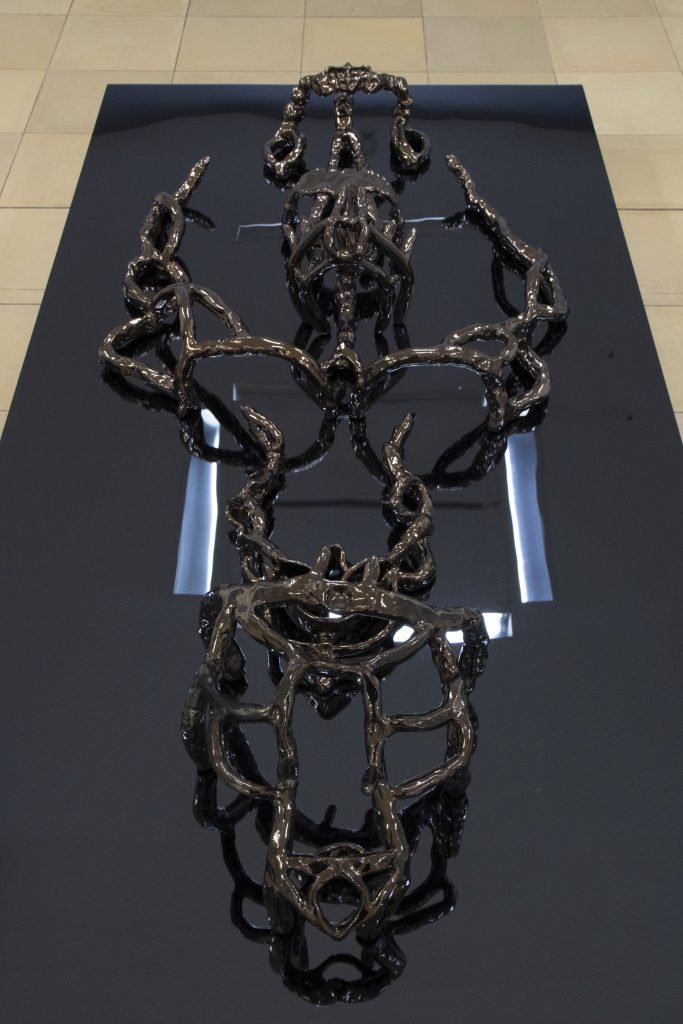
PART. 04
Yin: Do you have new projects for the next few years?
您在未来五年内有什么计划?
Hou: Within the next two years, I want to complete my Master studies at the University of Art and Design in Linz, Austria. After that, I am hoping to find and establish my own studio and continue focusing on my artistic practice to further explore different mediums of expression. In the following years, I would also like to realize larger sculptural projects in outdoor settings. I have had this idea for some time because I would like to facilitate a dialogue between my sculptures and chosen landscapes. The idea of permanently installing something that can be exposed to the seasons and daily weather conditions is appealing to me. Additionally, I like the idea of making the work accessible to everyone, at any time when they visit these landscapes. In the long term, I dream of creating or contributing to a communal workshop/studio space, ideally with great vegetable gardens and self-built clay huts : ).
I am curious to see what opportunities will show up!
在接下来的两年内,我想在奥地利林茨艺术与设计大学读完硕士学位。之后,我希望建立自己的工作室,继续专注于我的艺术实践,进一步探索不同的表达媒介。在接下来的几年里,我还想在户外环境中落实更大的雕塑项目。我产生这个想法已经有一段时间了,我想促进我的雕塑和所选景观之间的对话。有个想法很吸引我,我想永久性地装置一些可以暴露在四季和日常天气条件下的东西。此外,我也很喜欢让我的作品无论何时都能被其观众所感知和理解。从长远来看,我梦想创建或参与建设一个公共工作室/工作室空间,最好有漂亮的菜园和自建的粘土小屋 : )。
我也很好奇接下来会有什么样的机会等着我。
